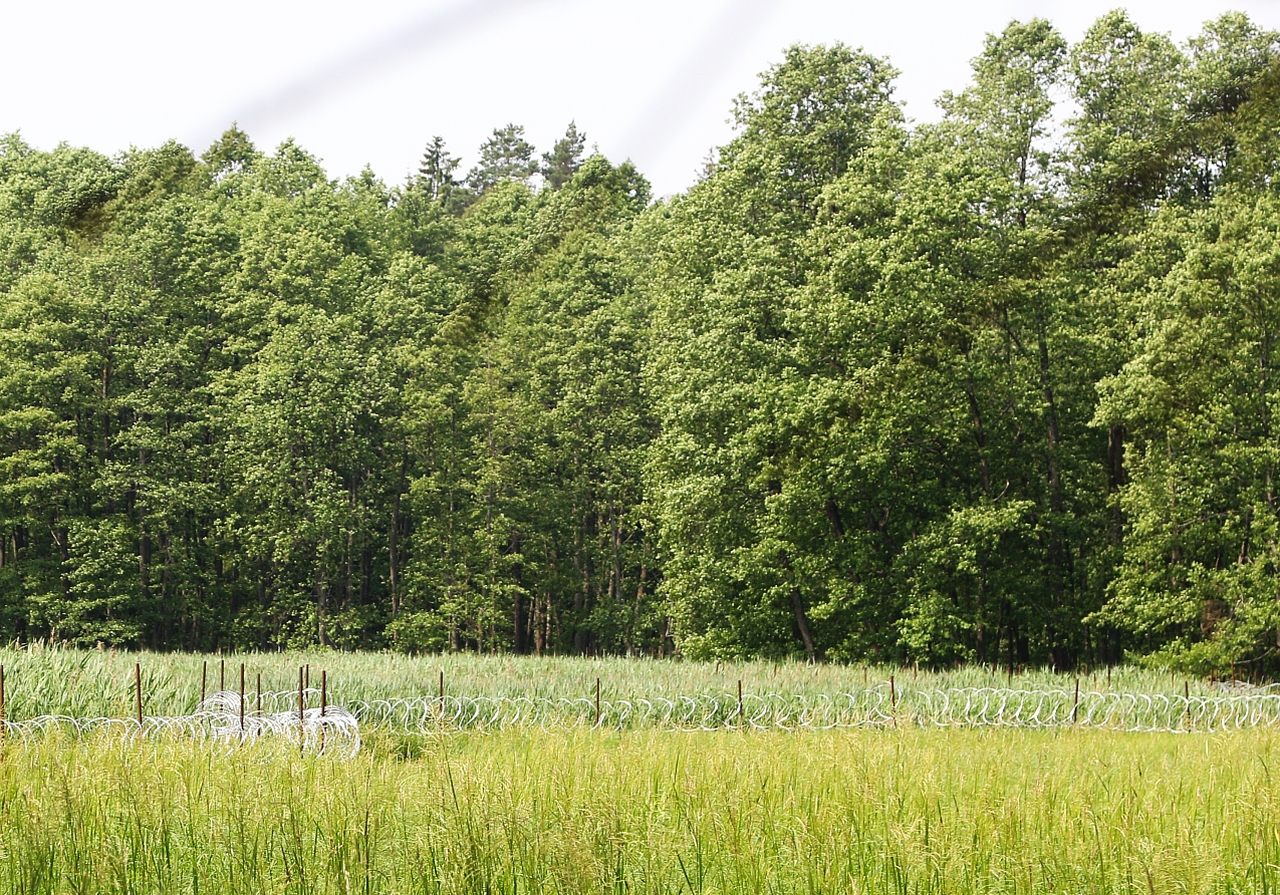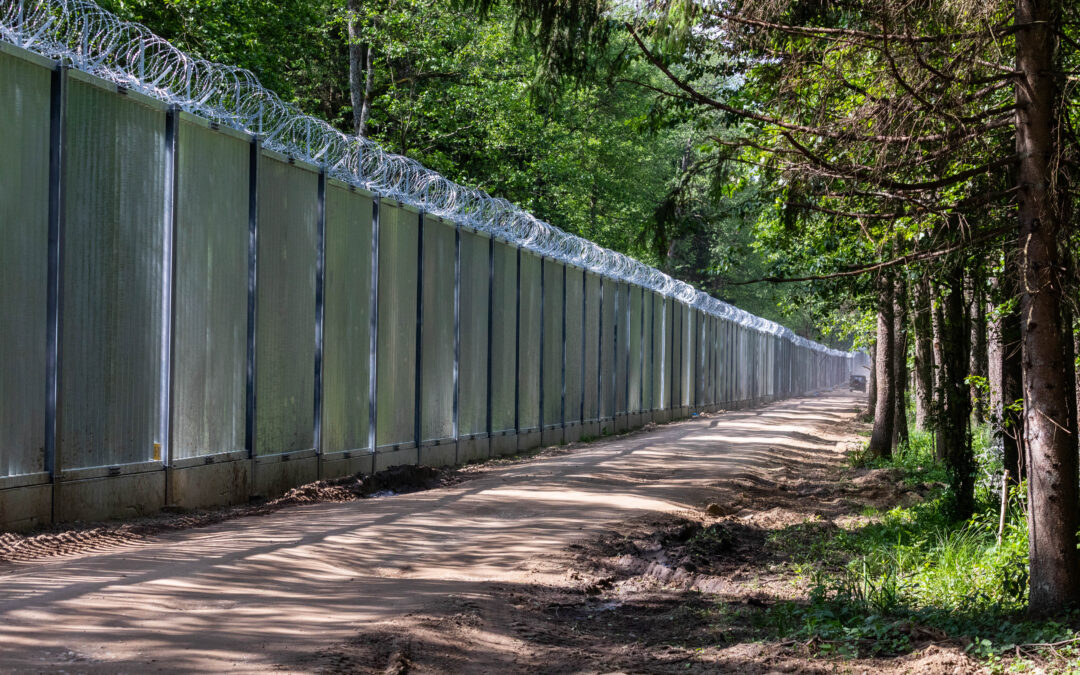By Tom Diserens
Since summer last year, Poland’s border with Belarus has been the scene of a man-made migration crisis created by the Belarusian regime. In response, the Polish government has constructed a five-metre-high wall along around half of the frontier to stymie the flow of those it regards as “illegal migrants”.
Built between January and June this year, the 187-km barrier runs through forests, swamps and meadows that are home to many rare species and habitats. Several of these natural areas, such as the Biebrza Marshes and Białowieża, Knyszyn, and Augustów forests, are protected under national and European law.
Consequently, scientists, NGOs and the environmental committee of the European Parliament have raised the alarm about the barrier’s environmental implications and compliance with EU directives. They say the construction will block ecological corridors, preventing the movement of animals.
In May, the European Commission wrote to Poland requesting assurances that the wall complies with European environmental law. The Polish government, however, maintains that it has implemented mitigation measures, resulting in no environmental harm being done. Who are we to believe in this debate?
Earlier this year, hundreds of scientists urged the EU to take action against Poland's border wall, which they said would have a “devastating” impact on the area’s valuable and delicate ecosystem https://t.co/CvLRCKi7wO
— Notes from Poland 🇵🇱 (@notesfrompoland) May 6, 2022
Prior to the barrier’s construction, the Polish side of the border was open: a 15-metre-wide deforested strip of land was all that marked the boundary with Belarus. By contrast, since the 1980s the Belarusian side has hosted a 2.5-metre barbed wire fence, called the Sistiema, which spans the entire length of the roughly 400-km border.
The new Polish barrier was built as quickly as possible. In November 2021, the Polish parliament passed a special act to regulate the wall’s construction, which exempted it from having to comply with environmental, flood defence and construction laws.
Importantly, this act bypassed the necessity to do an assessment of the barrier’s impact on the environment. Under EU law, such documents must be prepared for all projects that can potentially affect the integrity of Natura 2000 protected areas, of which there are many in eastern Poland.
To assist in managing the migrant crisis and in streamlining the barrier’s construction, the government also established an exclusion zone. From September last year until June this year, this zone barred non-residents from entering within a few kilometres of the border.
Since July, a narrower exclusion zone has banned the public from approaching within 200 metres of the barrier. These restrictions have prevented independent monitoring of the wall’s environmental impact.
In January, 1,400 scientists and a coalition of 160 NGOs petitioned the European Commission to intervene, warning that the wall would pose a permanent barrier to the connectivity of ecological corridors of the Natura 2000 network on a national and European level.
They requested that construction be halted until the government carries out an assessment of the barrier’s impact in accordance with EU environmental law.

The current exclusion zone along the border (image: Tom Diserens)
The scientists’ letter points out that linear landscape barriers are among the biggest threats to nature: they negatively affect gene flow between wildlife populations, disrupt the spatial and social organisation of animals, interrupt habitat use, disrupt reproduction and even threaten some species with extinction. Moreover, they warned that during construction tree felling and road upgrades would damage the conservation status of species and habitats.
In light of these protests, the European Commission wrote to the Polish government in April requesting more information. The commission will have to decide whether to initiate infringement proceedings after examining Warsaw’s response.
A succession of Polish government officials have denied that the barrier poses any threat to the environment. Małgorzata Golińska, the chief nature conservator and deputy environment minister, stated that an environmental impact assessment had in fact been carried out.
“The barrier would not negatively affect the environment,” she said, suggesting “it would even be a benefit to animals, which would no longer be exposed to the presence of humans on the border”.
The minister also emphasised that the Belarusian Sistiema already prevents migrations of large animals, adding that only wolves and lynx can pass the barbed wire fence, with great risk of injury.
The spokesperson for the General Directorate for Environmental Protection has backed up the minister’s claims. He stated that “the argument that the new wall on the border, on the Polish side, will form a barrier to animal migration is untrue and results either from ignorance or ill will”.
The head spokesperson for the Polish border guards reassured that the barrier contains 24 wildlife gates for large animals and over 140,000 channels for smaller ones to mitigate any potential environmental impact. She added that “the gates will be open all the time, if there is no pressure on the border”.
Two Białowieża-based biologists – Bogdan Jaroszewicz, director of Warsaw University’s Geobotanical Station, and Rafał Kowalczyk, former director of the Mammal Research Institute – recently published a response to these claims.
Their article questions the assertion that the wall will not impact the environment, pointing out that nobody has seen the environmental impact assessment the government claims to have carried out and expressing scepticism that the wildlife gates will facilitate animal migration (more on that below).
The scientists also noted their suspicion of the directorate for environmental protection’s support for the barrier. Although this government agency is responsible for protecting Poland’s natural environment, it is hardly an independent institution. Its director reports to the environment ministry and can be dismissed arbitrarily. The experts also show how the environment was harmed during the wall’s construction phase.
Presenting evidence from the strictly protected part of Białowieża National Park, they identified: 1) the likely felling of hundreds of trees adjacent to the border, 2) the damaging by heavy machinery of the bark and roots of many trees, 3) the spilling of road building materials into the forest, 4) the emitting of light and sound pollution, causing animals such as wolves and lynx to stop using their habitat next to the border, and 4) the running over of several small protected species, such as grass snakes and slow worms.
In response to the claims that the Sistiema of fencing on the Belarusian side already blocked transboundary animal movements, the Mammal Research Institute has presented evidence to the contrary. Its findings show that the Belarusian fence only prevented the movement of a few of the 60 wild mammals inhabiting Białowieża Forest.
For example, lynx are known to cross the border up to 50-60 times a year − this would not occur if, as claimed by the minister, it entailed great risk of injury. Wolves are known to dig holes under the Sistiema, and deer on either side of the border are known to interbreed.
Furthermore, the government promised there will be no physical barrier along most of Poland’s border with Belarus, particularly along the Bug and Swisłoć Rivers and other wetlands.
Yet these areas are currently lined with concertina wire, which is likely impassable for wild animals. In a response to a query by the Mammal Research Institute, the border guards stated this wire is only a temporary solution and will be removed once they finish building the planned “electronic barrier”. It remains to be seen whether the government sticks to its promise.

Barbed wire at the border (image: Rafał Kowalczyk)
Speaking to Notes from Poland, Krzysztof Schmidt of the Mammal Research Institute noted how the wildlife gates may end up being poor ecological corridors. The border guards plan to keep them closed during periods of high migration pressure and open them during quiet periods.
They also claim they will monitor animals approaching the wall, opening the gates temporarily to facilitate their movement across the border. But Prof. Schmidt noted this approach will be highly unpredictable for wildlife, which often require months if not years to become accustomed to new landscape features.
“Animals will not stand in a queue at the wall waiting for gates to be opened,” he noted.
According to Schmidt, the barrier’s most serious threat is perhaps to the survival of the endangered Białowieża lynx population. He stated that “the 10-15 lynx inhabiting the Polish side of Białowieża Forest have become isolated, as if living on an island”.
“Without new individuals crossing from Belarus, the risk of inbreeding will be high, as will be the threat from random events such as disease and poaching,” he added.
As long as the wildlife gates remain closed, the future for the lynx in Białowieża Forest – which already have the smallest genetic variation of any Eurasian lynx population in the world – appears bleak.
The lynx population will likely need micromanaging, as occurs with large predators in South Africa. There, national parks are fenced, and wildlife managers regularly move individuals between parks to replenish populations and prevent inbreeding.
This is difficult and expensive, but may be the only option if the species is to survive in northeast Poland.
The bear’s return to the Polish lowlands is also threatened. Although the species went extinct here in 1947, a male bear recently crossed into Poland, spending some time there before returning to the Belarusian side of Białowieża Forest. Hopes were high that more bears would follow. Yet if the wildlife gates remain closed, this may never happen.
The barrier’s ultimate impact rests on three as yet unanswered questions.
First, will the wildlife gates ever be open? Second, will a proper, public environmental assessment ever be done that could identify the need for further mitigation measures? Third, will the barrier be taken down one day? This could happen if the migrant crisis abates, with a change of government in Poland, or perhaps as a consequence of a change of politics in Belarus.
In time we may receive answers to these questions. But for now, the future for wildlife on Poland’s eastern border appears uncertain.
Main image credit: Rafał Kowalczyk





















